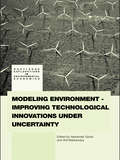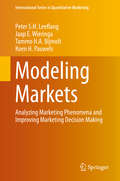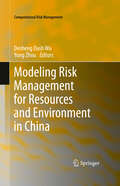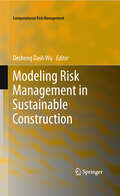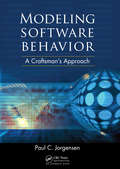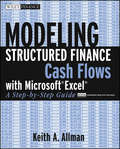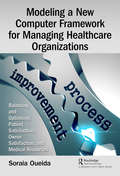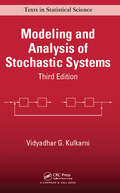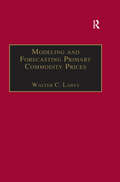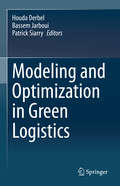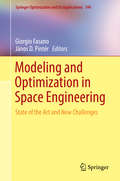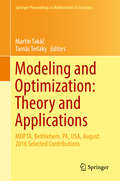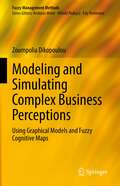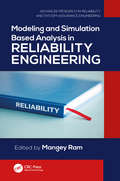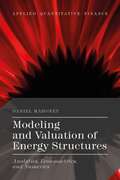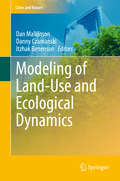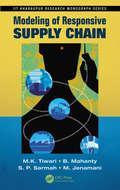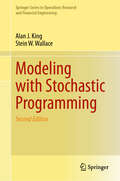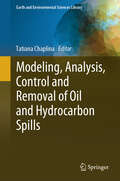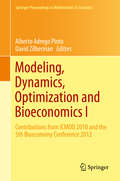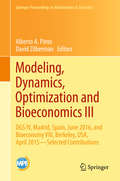- Table View
- List View
Modeling Environment-Improving Technological Innovations under Uncertainty (Routledge Explorations in Environmental Economics)
by Anil Markandya Alexander A. GolubThe issues of technology and uncertainty are very much at the heart of the policy debate of how much to control greenhouse gas emissions. The costs of doing so are present and high while the benefits are very much in the future and, most importantly, they are highly uncertain. Whilst there is broad consensus on the key elements of climate change science and agreement that near-term actions are needed to prevent dangerous anthropogenic interference with the climate system, there is little agreement on the costs and benefits of climate policy. The book looks at different ways of reconciling the needs for sustainability and equity with the costs of action now. Presenting a compendium of methodologies for evaluating the economic impact of technological innovation upon climate-change policy, this book describes mathematical models and their predictions. The goal is to provide a practitioner’s guide for doing the science of economics and climate change. Because the assumptions motivating different problems in the economics of climate change have different complexities, a number of models are presented with varying levels of difficulty: reduced-form and structural, partial- and general-equilibrium, closed-form and computational. A unifying theme of these models is the incorporation of a number of price and quantity instruments and an analysis of their respective efficacies. This book presents models that contain structural uncertainty, i.e., uncertainty that economic agents respond to via their risk attitudes. The novelty of this book is to relate the effects of risk and risk attitudes to environment-improving technological innovation.
Modeling Markets
by Peter S. H. Leeflang Jaap E. Wieringa Tammo H. A. Bijmolt Koen H. PauwelsThis book is about how models can be developed to represent demand and supply on markets, where the emphasis is on demand models. Its primary focus is on models that can be used by managers to support marketing decisions. The market environment is changing rapidly and constantly. Prior to the introduction of scanner equipment in retail outlets, ACNielsen, the major supplier of information on brand performance, claimed that its business was to provide the score but not to explain or predict it. With technological advances and the introduction of the Internet, the opportunity to obtain meaningful estimates of demand functions has vastly improved; models that provide information about the sensitivity of market behavior to marketing activities such as advertising, pricing, promotions and distribution are now routinely used by managers for the identification of changes in marketing programs that can improve brand performance. In today's environment of information overload, the challenge is to make sense of the data that is being provided globally, in real time, from thousands of sources. Modeling Markets presents a comprehensive overview of the tools and methodologies that managers can use in decision making. It has long been known that even simple models outperform judgments in predicting outcomes in a wide variety of contexts. More complex models potentially provide insights about structural relations not available from casual observations. Although marketing models are now widely accepted, the quality of the marketing decisions is critically dependent upon the quality of the models on which those decisions are based. In this book, the authors present a wealth of insights developed at the forefront of the field, covering all key aspects of specification, estimation, validation and use of models. The most current insights and innovations in quantitative marketing are presented, including in-depth discussion of Bayesian estimation methods. Throughout the book, the authors provide examples and illustrations. This book will be of interest to researchers, analysts, managers and students who want to understand, develop or use models of marketing phenomena.
Modeling Monetary Economies
by Scott Freeman Bruce Champ Joseph HaslagThe approach of this text is to teach monetary economics using the classical paradigm of rational agents in a market setting. Too often monetary economics has been taught as a collection of facts about existing institutions for students to memorize. By teaching from first principles instead, the authors aim to instruct students not only in the monetary policies and institutions that exist today in the United States and Canada, but also in what policies and institutions may or should exist tomorrow and elsewhere. The text builds on a simple, clear monetary model and applies this framework consistently to a wide variety of monetary questions. The authors have added in this third edition new material on money as a means of replacing imperfect social record keeping, the role of currency in banking panics, and a description of the policies implemented to deal with the banking crises that began in 2007.
Modeling Risk Management for Resources and Environment in China
by Desheng Dash Wu Yong ZhouThis edited volume expands the scope of risk management beyond finance to include resources and environment issues in China. It presents the state-of-the-art approaches of using risk management to effectively manage resources and environment. Both case studies and theoretical methodologies are discussed.
Modeling Risk Management in Sustainable Construction
by Desheng Dash WuIn this edited volume, we present the state-of-the-art views of the perspective of enterprise risk management, to include frameworks and controls in the ERM process with respect to supply chains, constructions, and project, energy, environmental and sustainable development risk management. The bulk of this volume is devoted to presenting a number of modeling approaches that have been (or could be) applied to enterprise risk management in construction.
Modeling Software Behavior: A Craftsman's Approach
by Paul C. JorgensenThis book provides engineers, developers, and technicians with a detailed treatment of various models of software behavior that will support early analysis, comprehension, and model-based testing. The expressive capabilities and limitations of each behavioral model are also discussed.
Modeling Structural Change in the U.S. Textile Industry (Studies on Industrial Productivity: Selected Works)
by Shu Yang Barry K. GoodwinFirst Published in 2000. Routledge is an imprint of Taylor & Francis, an informa company.
Modeling Structured Finance Cash Flows with MicrosoftExcel
by Allman Keith A.A practical guide to building fully operational financial cash flow models for structured finance transactions Structured finance and securitization deals are becoming more commonplace on Wall Street. Up until now, however, market participants have had to create their own models to analyze these deals, and new entrants have had to learn as they go. Modeling Structured Finance Cash Flows with Microsoft Excel provides readers with the information they need to build a cash flow model for structured finance and securitization deals. Financial professional Keith Allman explains individual functions and formulas, while also explaining the theory behind the spreadsheets. Each chapter begins with a discussion of theory, followed by a section called "Model Builder," in which Allman translates the theory into functions and formulas. In addition, the companion CD-ROM features all of the modeling exercises, as well as a final version of the model that is created in the text. Note: CD-ROM/DVD and other supplementary materials are not included as part of eBook file.
Modeling a New Computer Framework for Managing Healthcare Organizations: Balancing and Optimizing Patient Satisfaction, Owner Satisfaction, and Medical Resources
by Soraia OueidaThe medical sector has been growing exponentially over the last decade and healthcare services are becoming more complex and costly. In order to continue efficiently and effectively managing patient safety, quality, and the effectiveness of the healthcare systems, new methodologies are needed. This book provides a platform to address this growing need and to improve practice. With the introduction of a new computer platform package for the management of medical organizations and healthcare systems, Modeling a New Computer Framework for Managing Healthcare Organizations aims to improve management techniques and increase overall satisfaction scores of patients, owners, and medical resources. The platform outlined will improve the daily operation of a healthcare system, focusing on the emergency department, and can be used to study the operation flow of a unit for performance optimization. It offers a user-friendly interface and proposed programming language, along with a visual and simple practice to collect and understand statistical outputs. Essential reading for decision makers on different levels in the healthcare organization hierarchy, this book can also be used by management to improve the performance of the organization and decision makers to hire resources, enhance workflows or both. It guides designers and system implementers in a step-by-step approach to make optimal decisions for resource allocation and helps designers and management to detect deficiencies in ongoing processes and fix or enhance them. Soraia Oueida is an instructor in the Department of Computer Engineering at the American University of the Middle East. She is an IEEE member and her research interests include Simulation Modeling, Discrete Mathematics, Petri Net, Workflows, Blockchain, IoT, Industrial Management Systems.
Modeling and Analysis of Stochastic Systems (Chapman & Hall/CRC Texts in Statistical Science)
by Vidyadhar G. KulkarniBuilding on the author’s more than 35 years of teaching experience, Modeling and Analysis of Stochastic Systems, Third Edition, covers the most important classes of stochastic processes used in the modeling of diverse systems. For each class of stochastic process, the text includes its definition, characterization, applications, transient and limiting behavior, first passage times, and cost/reward models. The third edition has been updated with several new applications, including the Google search algorithm in discrete time Markov chains, several examples from health care and finance in continuous time Markov chains, and square root staffing rule in Queuing models. More than 50 new exercises have been added to enhance its use as a course text or for self-study. The sequence of chapters and exercises has been maintained between editions, to enable those now teaching from the second edition to use the third edition. Rather than offer special tricks that work in specific problems, this book provides thorough coverage of general tools that enable the solution and analysis of stochastic models. After mastering the material in the text, readers will be well-equipped to build and analyze useful stochastic models for real-life situations.
Modeling and Forecasting Primary Commodity Prices
by Walter C. LabysRecent economic growth in China and other Asian countries has led to increased commodity demand which has caused price rises and accompanying price fluctuations not only for crude oil but also for the many other raw materials. Such trends mean that world commodity markets are once again under intense scrutiny. This book provides new insights into the modeling and forecasting of primary commodity prices by featuring comprehensive applications of the most recent methods of statistical time series analysis. The latter utilize econometric methods concerned with structural breaks, unobserved components, chaotic discovery, long memory, heteroskedasticity, wavelet estimation and fractional integration. Relevant tests employed include neural networks, correlation dimensions, Lyapunov exponents, fractional integration and rescaled range. The price forecasting involves structural time series trend plus cycle and cyclical trend models. Practical applications focus on the price behaviour of more than twenty international commodity markets.
Modeling and Optimization in Green Logistics
by Patrick Siarry Bassem Jarboui Houda DerbelThis book presents recent work that analyzes general issues of green logistics and smart cities. The contributed chapters consider operating models with important ecological, economic, and social objectives.The content will be valuable for researchers and postgraduate students in computer science, information technology, industrial engineering, and applied mathematics.
Modeling and Optimization in Space Engineering: State of the Art and New Challenges (Springer Optimization and Its Applications #144)
by Giorgio Fasano János D. PintérThis book presents advanced case studies that address a range of important issues arising in space engineering. An overview of challenging operational scenarios is presented, with an in-depth exposition of related mathematical modeling, algorithmic and numerical solution aspects. The model development and optimization approaches discussed in the book can be extended also towards other application areas. The topics discussed illustrate current research trends and challenges in space engineering as summarized by the following list: • Next Generation Gravity Missions • Continuous-Thrust Trajectories by Evolutionary Neurocontrol • Nonparametric Importance Sampling for Launcher Stage Fallout • Dynamic System Control Dispatch • Optimal Launch Date of Interplanetary Missions • Optimal Topological Design • Evidence-Based Robust Optimization • Interplanetary Trajectory Design by Machine Learning • Real-Time Optimal Control • Optimal Finite Thrust Orbital Transfers • Planning and Scheduling of Multiple Satellite Missions • Trajectory Performance Analysis • Ascent Trajectory and Guidance Optimization • Small Satellite Attitude Determination and Control • Optimized Packings in Space Engineering • Time-Optimal Transfers of All-Electric GEO Satellites Researchers working on space engineering applications will find this work a valuable, practical source of information. Academics, graduate and post-graduate students working in aerospace, engineering, applied mathematics, operations research, and optimal control will find useful information regarding model development and solution techniques, in conjunction with real-world applications.
Modeling and Optimization: Theory and Applications
by Tamás Terlaky Martin TakáčThis volume contains a selection of contributions that were presented at the Modeling and Optimization: Theory and Applications Conference (MOPTA) held at Lehigh University in Bethlehem, Pennsylvania, USA on August 17-19, 2016. The conference brought together a diverse group of researchers and practitioners, working on both theoretical and practical aspects of continuous or discrete optimization. Topics presented included algorithms for solving convex, network, mixed-integer, nonlinear, and global optimization problems, and addressed the application of deterministic and stochastic optimization techniques in energy, finance, logistics, analytics, health, and other important fields. The contributions contained in this volume represent a sample of these topics and applications and illustrate the broad diversity of ideas discussed at the meeting.
Modeling and Simulating Complex Business Perceptions: Using Graphical Models and Fuzzy Cognitive Maps (Fuzzy Management Methods)
by Zoumpolia DikopoulouFuzzy cognitive maps (FCMs) have gained popularity in the scientific community due to their capabilities in modeling and decision making for complex problems.This book presents a novel algorithm called glassoFCM to enable automatic learning of FCM models from data. Specifically, glassoFCM is a combination of two methods, glasso (a technique originated from machine learning) for data modeling and FCM simulation for decision making. The book outlines that glassoFCM elaborates simple, accurate, and more stable models that are easy to interpret and offer meaningful decisions. The research results presented are based on an investigation related to a real-world business intelligence problem to evaluate characteristics that influence employee work readiness.Finally, this book provides readers with a step-by-step guide of the 'fcm' package to execute and visualize their policies and decisions through the FCM simulation process.
Modeling and Simulation Based Analysis in Reliability Engineering (Advanced Research in Reliability and System Assurance Engineering)
by Mangey RamRecent developments in reliability engineering has become the most challenging and demanding area of research. Modeling and Simulation, along with System Reliability Engineering has become a greater issue because of high-tech industrial processes, using more complex systems today. This book gives the latest research advances in the field of modeling and simulation, based on analysis in engineering sciences. Features Focuses on the latest research in modeling and simulation based analysis in reliability engineering. Covers performance evaluation of complex engineering systems Identifies and fills the gaps of knowledge pertaining to engineering applications Provides insights on an international and transnational scale Modeling and Simulation Based Analysis in Reliability Engineering aims at providing a reference for applications of mathematics in engineering, offering a theoretical sound background with adequate case studies, and will be of interest to researchers, practitioners, and academics.
Modeling and Valuation of Energy Structures: Analytics, Econometrics, and Numerics (Applied Quantitative Finance)
by Daniel MahoneyCommodity markets present several challenges for quantitative modeling. These include high volatilities, small sample data sets, and physical, operational complexity. In addition, the set of traded products in commodity markets is more limited than in financial or equity markets, making value extraction through trading more difficult. These facts make it very easy for modeling efforts to run into serious problems, as many models are very sensitive to noise and hence can easily fail in practice. Modeling and Valuation of Energy Structures is a comprehensive guide to quantitative and statistical approaches that have been successfully employed in support of trading operations, reflecting the author's 17 years of experience as a front-office 'quant'. The major theme of the book is that simpler is usually better, a message that is drawn out through the reality of incomplete markets, small samples, and informational constraints. The necessary mathematical tools for understanding these issues are thoroughly developed, with many techniques (analytical, econometric, and numerical) collected in a single volume for the first time. A particular emphasis is placed on the central role that the underlying market resolution plays in valuation. Examples are provided to illustrate that robust, approximate valuations are to be preferred to overly ambitious attempts at detailed qualitative modeling.
Modeling and Valuation of Energy Structures: Analytics, Econometrics, and Numerics (Applied Quantitative Finance)
by Daniel MahoneyCommodity markets present several challenges for quantitative modeling. These include high volatilities, small sample data sets, and physical, operational complexity. In addition, the set of traded products in commodity markets is more limited than in financial or equity markets, making value extraction through trading more difficult. These facts make it very easy for modeling efforts to run into serious problems, as many models are very sensitive to noise and hence can easily fail in practice. Modeling and Valuation of Energy Structures is a comprehensive guide to quantitative and statistical approaches that have been successfully employed in support of trading operations, reflecting the author's 17 years of experience as a front-office 'quant'. The major theme of the book is that simpler is usually better, a message that is drawn out through the reality of incomplete markets, small samples, and informational constraints. The necessary mathematical tools for understanding these issues are thoroughly developed, with many techniques (analytical, econometric, and numerical) collected in a single volume for the first time. A particular emphasis is placed on the central role that the underlying market resolution plays in valuation. Examples are provided to illustrate that robust, approximate valuations are to be preferred to overly ambitious attempts at detailed qualitative modeling.
Modeling of Land-Use and Ecological Dynamics
by Dan Malkinson Danny Czamanski Itzhak BenensonAs cities are rapidly expanding and encroaching into agricultural and natural areas, a question of primary concern is how this expansion affects surrounding agriculture and natural landscapes. This book presents a wide spectrum of both theoretical and empirical approaches to simulation and assessment of landscape dynamics. The first part presents state-of-the-art modelling approaches pertaining to land-use changes entailed by the urban sprawl, at different spatial resolutions and temporal time scales. The second part is dedicated to case studies of the effects and consequences of the emerging urban-agriculture open space patterns.
Modeling of Responsive Supply Chain
by M.K. Tiwari B. Mahanty S. P. Sarmah M. JenamaniA guide to help readers meet the demands of an evolving competitive business environment, Modeling of Responsive Supply Chain outlines novel concepts and strategies for implementing a fully integrated system of business improvement methodologies.This self-contained reference covers various key aspects of supply chain management, which is crucial to
Modeling the World Economic Outlook at the IMF: A Historical Review
by James M. BoughtonA report from the International Monetary Fund.
Modeling with Stochastic Programming (Springer Series in Operations Research and Financial Engineering)
by Alan J. King Stein W. WallaceThis is an updated version of what is still the only text to address basic questions about how to model uncertainty in mathematical programming, including how to reformulate a deterministic model so that it can be analyzed in a stochastic setting. This second edition has important extensions regarding how to represent random phenomena in the models (also called scenario generation) as well as a new chapter on multi-stage models. This text would be suitable as a stand-alone or supplement for a second course in OR/MS or in optimization-oriented engineering disciplines where the instructor wants to explain where models come from and what the fundamental modeling issues are. The book is easy-to-read, highly illustrated with lots of examples and discussions. It will be suitable for graduate students and researchers working in operations research, mathematics, engineering and related departments where there is interest in learning how to model uncertainty. Alan King is a Research Staff Member at IBM's Thomas J. Watson Research Center in New York. Stein W. Wallace is a Professor of Operational Research and head of Center for Shipping and Logistics at NHH Norwegian School of Economics, Bergen, Norway.
Modeling, Analysis, Control and Removal of Oil and Hydrocarbon Spills (Earth and Environmental Sciences Library)
by Tatiana ChaplinaA large number of scientific works are devoted to the study and modeling of accidental oil spills. However, there is no single approach to the description of processes and a generally accepted system of models. An additional fundamental difficulty is the impossibility of conducting full-fledged full-scale experimental studies, which makes it difficult to verify the adequacy and accuracy of oil spill models. Our book is devoted to the problems of experimental investigation and theoretical description of spills, as well as the practical removal of various petroleum products from the water surface and ice. It provides an overview of the most well-known theoretical models of the process of spreading oil stains on the water surface. Also, in the relevant sections, an original spreading model based on an energy approach is proposed and analyzed. The results of new experimental studies of the dynamics of the process for various hydrocarbons on water, including variations in its temperatureand salinity, are presented. In the following chapters, a theoretical description of oil spreading on the upper and lower surfaces of floating ice is proposed, modeling phenomena in the Arctic and subarctic zones of the world ocean. New experimental data on the spreading of petroleum products on the ice surface are presented. The final part provides a brief overview of the existing most used and promising methods for removing of hydrocarbons from the water surface. New original constructive solutions to this problem are proposed, the technical characteristics of which have received theoretical justification and experimental confirmation.
Modeling, Dynamics, Optimization and Bioeconomics I
by David Zilberman Alberto Adrego PintoThis volume explores the emerging and current, cutting-edge theories and methods of modeling, optimization, dynamics and bio economy. It provides an overview of the main issues, results and open questions in these fields as well as covers applications to biology, economy, energy, industry, physics, psychology and finance. The majority of the contributed papers for this volume come from the participants of the International Conference on Modeling, Optimization and Dynamics (ICMOD 2010), a satellite conference of EURO XXIV Lisbon 2010, which took place at Faculty of Sciences of University of Porto, Portugal and from the Berkeley Bio economy Conference 2012, at the University of California, Berkeley, USA.
Modeling, Dynamics, Optimization and Bioeconomics III: Contributions From Dgs Iii And The 7th Bioeconomy Conference 2014 (Springer Proceedings in Mathematics & Statistics #195)
by David Zilberman Alberto A. PintoThe research and review papers presented in this volume provide an overview of the main issues, findings, and open questions in cutting-edge research on the fields of modeling, optimization and dynamics and their applications to biology, economics, energy, finance, industry, physics and psychology. Given the scientific relevance of the innovative applications and emerging issues they address, the contributions to this volume, written by some of the world’s leading experts in mathematics, economics and other applied sciences, will be seminal to future research developments and will spark future works and collaborations. The majority of the papers presented in this volume were written by participants of the 4th International Conference on Dynamics, Games and Science: Decision Models in a Complex Economy (DGS IV), held at the National Distance Education University (UNED) in Madrid, Spain in June 2016 and of the 8th Berkeley Bioeconomy Conference: The Future of Biofuels, held at the UC Berkeley Alumni House in April 2015.
